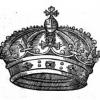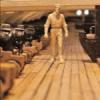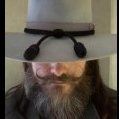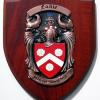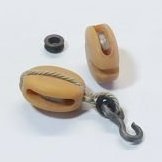
JerseyCity Frankie
-
Posts
1,338 -
Joined
-
Last visited
Reputation Activity
-
 JerseyCity Frankie reacted to dafi in Thinking things throu, the gunroom / gunner´s room
JerseyCity Frankie reacted to dafi in Thinking things throu, the gunroom / gunner´s room
Look I just cleared for action ;-)
Not better or worse than any other battle station :-)
XXXDAn
-
 JerseyCity Frankie got a reaction from Jason in Patrick O'Brian's Aubry/Maturin Series
JerseyCity Frankie got a reaction from Jason in Patrick O'Brian's Aubry/Maturin Series
Two English fans loved the books so much, and love cooking too, to the extent that they researched all the meals and foods mentioned in the O'Brian novels and wrote a cookbook! It's called Lobscouse & Spotted Dog and contains instructions and comments on such fair as:
Skillygalee, Pig's Fry, Shrewsburry Cakes, Haggis, Turtle Soup, Pig's Trotters, Figgy-Dowdy, Drowned Baby, Dog's Nose, and also of course Lobscouse and Spotted Dog.
Here is the recipe for Soused Hogs Face.
From the book Lobscouse & Spotted Dog by Anne Chotzinoff Grossman and Lisa Grossman Thomas
1 pig’s head, about 10 pounds, cleaned but not skinned
2 pounds (6 cups) white cornmeal
3 cups white wine
1 cup water
2 bay leaves
1 tablespoon salt
12 peppercorns
1 knob fresh ginger, sliced
1 nutmeg cut in half
Place the head in a large bucket with half the cornmeal and cold water. Soak 2 hours or longer.
Remove the head from the water, rinse well, and place in a large pot with the remaining cornmeal and water to cover. Bring to a boil, covered, and simmer 3 hours. Remove from pot. When it is just cool enough to handle, pick all meat from the bones. Reserve the tongue and ears.
Wring out a cloth in warm water. Put all the meat into the cloth and tie up as tightly as possible. Chill until firm.
Combine the wine, vinegar, 1 cup water, and the spices. Untie the cloth and pack the meat into a crock. Add the tongue and ears. Pour the wine mixture over the meat. Weight the meat to keep it submerged. Seal the crock and store in a cool dark place for up to 2 weeks before serving.
Serves 6
-
 JerseyCity Frankie got a reaction from bart430 in Patrick O'Brian's Aubry/Maturin Series
JerseyCity Frankie got a reaction from bart430 in Patrick O'Brian's Aubry/Maturin Series
Two English fans loved the books so much, and love cooking too, to the extent that they researched all the meals and foods mentioned in the O'Brian novels and wrote a cookbook! It's called Lobscouse & Spotted Dog and contains instructions and comments on such fair as:
Skillygalee, Pig's Fry, Shrewsburry Cakes, Haggis, Turtle Soup, Pig's Trotters, Figgy-Dowdy, Drowned Baby, Dog's Nose, and also of course Lobscouse and Spotted Dog.
Here is the recipe for Soused Hogs Face.
From the book Lobscouse & Spotted Dog by Anne Chotzinoff Grossman and Lisa Grossman Thomas
1 pig’s head, about 10 pounds, cleaned but not skinned
2 pounds (6 cups) white cornmeal
3 cups white wine
1 cup water
2 bay leaves
1 tablespoon salt
12 peppercorns
1 knob fresh ginger, sliced
1 nutmeg cut in half
Place the head in a large bucket with half the cornmeal and cold water. Soak 2 hours or longer.
Remove the head from the water, rinse well, and place in a large pot with the remaining cornmeal and water to cover. Bring to a boil, covered, and simmer 3 hours. Remove from pot. When it is just cool enough to handle, pick all meat from the bones. Reserve the tongue and ears.
Wring out a cloth in warm water. Put all the meat into the cloth and tie up as tightly as possible. Chill until firm.
Combine the wine, vinegar, 1 cup water, and the spices. Untie the cloth and pack the meat into a crock. Add the tongue and ears. Pour the wine mixture over the meat. Weight the meat to keep it submerged. Seal the crock and store in a cool dark place for up to 2 weeks before serving.
Serves 6
-
 JerseyCity Frankie reacted to deckape in Charles W Morgan by deckape - Marine Model Company - 5/32 Scale - whaler
JerseyCity Frankie reacted to deckape in Charles W Morgan by deckape - Marine Model Company - 5/32 Scale - whaler
Ahoy
New here to the forum although I signed up many years back but never posted anything so I will start with this one. Okay shipmates this is a out of production and lost forgotten kit manufacture of yesteryear. I obtained this kit in 1954 been working on her off and on for decades on end now its time to get her done. The hull is still being fitted out and I just completed the three mast assemblies these old Marine model kits are old school kits back in those days they give you everything but a display case back then I paid $14.95 a lot of money back in that day but well spent compared today. Okay here are the pictures of what I have done thus far. I have a long way to go and it will all be posted here.
Boats
-
 JerseyCity Frankie reacted to deckape in Pride of Baltimore by deckape - Model Shipways - Baltimore clipper
JerseyCity Frankie reacted to deckape in Pride of Baltimore by deckape - Model Shipways - Baltimore clipper
Ahoy
I ma working on this one next to my Charles Morgan whale Ship back to back builds Matter of fact I am working on 7 of these ships of sail. I got this kit for my 64th birthday 10 years ago looked like a great kit to build this is the first time I had seen a plank on bulkhead construction usually they are all solid hulls. As of now I am working on the main mast and the channels and chain plates will follow next and she to will be ready for the standing rigging.
Boats
-
 JerseyCity Frankie got a reaction from mtaylor in Thinking things throu, Kit Bags
JerseyCity Frankie got a reaction from mtaylor in Thinking things throu, Kit Bags
A nautical hobby of mine, parallel to model building, is canvas sewing. I use the traditional Palm and Needle sewing of the sailmaker and the canvas I use is from the art supply store, intended for painters but available by the yard in many thicknesses. Pictured here are my ditty bag, which I use to hold my sailor tools just like back in the old days. Mine is a more modern design though. Next is the sort of tote bag I make and give as gifts.I have made about twenty of these over the years. I try to incorporate discarded line and canvas I pull out of dumpsters at my local marina. Last is a pair of pants I sewed. I had read that sailors were issued sailcloth and were allowed on Sundays to make and mend their clothing, so I sewed a pair for myself.
The sewing methods, the seam construction, the edge roping and grommeting is all done exactly the way it is done on handsewn sails.
-
 JerseyCity Frankie got a reaction from dafi in Thinking things throu, Kit Bags
JerseyCity Frankie got a reaction from dafi in Thinking things throu, Kit Bags
A nautical hobby of mine, parallel to model building, is canvas sewing. I use the traditional Palm and Needle sewing of the sailmaker and the canvas I use is from the art supply store, intended for painters but available by the yard in many thicknesses. Pictured here are my ditty bag, which I use to hold my sailor tools just like back in the old days. Mine is a more modern design though. Next is the sort of tote bag I make and give as gifts.I have made about twenty of these over the years. I try to incorporate discarded line and canvas I pull out of dumpsters at my local marina. Last is a pair of pants I sewed. I had read that sailors were issued sailcloth and were allowed on Sundays to make and mend their clothing, so I sewed a pair for myself.
The sewing methods, the seam construction, the edge roping and grommeting is all done exactly the way it is done on handsewn sails.
-
 JerseyCity Frankie got a reaction from CaptainSteve in Thinking things throu, Kit Bags
JerseyCity Frankie got a reaction from CaptainSteve in Thinking things throu, Kit Bags
A nautical hobby of mine, parallel to model building, is canvas sewing. I use the traditional Palm and Needle sewing of the sailmaker and the canvas I use is from the art supply store, intended for painters but available by the yard in many thicknesses. Pictured here are my ditty bag, which I use to hold my sailor tools just like back in the old days. Mine is a more modern design though. Next is the sort of tote bag I make and give as gifts.I have made about twenty of these over the years. I try to incorporate discarded line and canvas I pull out of dumpsters at my local marina. Last is a pair of pants I sewed. I had read that sailors were issued sailcloth and were allowed on Sundays to make and mend their clothing, so I sewed a pair for myself.
The sewing methods, the seam construction, the edge roping and grommeting is all done exactly the way it is done on handsewn sails.
-
 JerseyCity Frankie reacted to dafi in HMS Victory by dafi - Heller - PLASTIC - To Victory and beyond ...
JerseyCity Frankie reacted to dafi in HMS Victory by dafi - Heller - PLASTIC - To Victory and beyond ...
And on we go with some trifles :-)
I was wondering how to create furniture without it looking like dollhouse toys. Ok, off I went to find out.
Luckily I was successful, only have to stick to the true dimensions :-)
Here the substructure, fast done and quite stable.
Contemporary drawings always show the tables direction fore aft, so I displayed them over the massive partner of the sternpost. Like this canvas cabins could be erected on the ship´s sides.
The openings on the deck are no litter bins but aft there are the two scuttles of the ventilation trunks of the hold and in the front the scuttle for the bread room and in the middle the one for the Lady´s hole, means the stuff of the gunner. The gratings are flipped open for better ventilation.
Here we already have the name of the area, the gun room. The gunner had his quarters here and was then highest warrent officer in this area.He had a canvas cabin on starboard and larboard was the one from the chaplin. The area also was the mess for the warrent officers, junior lieutenants, marine officers and first class volunteers. Here also the chaplin taught the junior midshipmen. The Area was separeted from the rest of the deck by means of canvas covers.
Still have to redo the canvas blinds, but they work well as layout separations.
I hope, I got the details right,
cheers Daniel
PS: Could not resist to show the Tic Tac in place :-)
-
 JerseyCity Frankie got a reaction from cardely in Question about bolt ropes
JerseyCity Frankie got a reaction from cardely in Question about bolt ropes
The Sailmakers Apprentice, by Emilliano Marino, is an excelent 494 page WELL ILLUSTRATED source for real world traditional sail construction information. Its a complex subject with no "one size fits all" answer but what I see in the book dovetails with what Cardely says above: The boltrope originates at one of the corners of the sail and runs around the edge of the sail, sometimes but not always in one continuous piece of rope. Often though changing diameters on different facets of the sail and thus many ropes are spliced together. The eyes at the corners were either spliced or seized eyes. There is a small galaxy of possible splices a person can put into a rope but they all involve unlaying the strands and tucking these individual strands in very particular patterns back into the rope or into the next rope. These tucks make one rope appear to seamlessly blend into another. If you google "long splice" or "short splice" or "Eye Splice" you will get lots of helpful diagrams.
The sort of juncture at the corners of a square sail are achieved by either seizing an eye into the part of the rope that goes around the corner of the sail or short splicing one rope into the eye of the other. For instance if your headrope has an eye spliced in each end at the earrings, the leach boltropes can be spliced into these eyes at a 90 degree angle.
This sort of very elaborate splicing would only be duplicated on a very large highly detailed model. Seized eyes are likely all you really need. As to what to do with the ends, its easy enough to unlay a bit of the thread you are using and smooth the strands up against the other end with some white glue to hold it in place and in that way avoid an obvious visible juncture.
-
 JerseyCity Frankie got a reaction from JesseLee in Question about bolt ropes
JerseyCity Frankie got a reaction from JesseLee in Question about bolt ropes
The Sailmakers Apprentice, by Emilliano Marino, is an excelent 494 page WELL ILLUSTRATED source for real world traditional sail construction information. Its a complex subject with no "one size fits all" answer but what I see in the book dovetails with what Cardely says above: The boltrope originates at one of the corners of the sail and runs around the edge of the sail, sometimes but not always in one continuous piece of rope. Often though changing diameters on different facets of the sail and thus many ropes are spliced together. The eyes at the corners were either spliced or seized eyes. There is a small galaxy of possible splices a person can put into a rope but they all involve unlaying the strands and tucking these individual strands in very particular patterns back into the rope or into the next rope. These tucks make one rope appear to seamlessly blend into another. If you google "long splice" or "short splice" or "Eye Splice" you will get lots of helpful diagrams.
The sort of juncture at the corners of a square sail are achieved by either seizing an eye into the part of the rope that goes around the corner of the sail or short splicing one rope into the eye of the other. For instance if your headrope has an eye spliced in each end at the earrings, the leach boltropes can be spliced into these eyes at a 90 degree angle.
This sort of very elaborate splicing would only be duplicated on a very large highly detailed model. Seized eyes are likely all you really need. As to what to do with the ends, its easy enough to unlay a bit of the thread you are using and smooth the strands up against the other end with some white glue to hold it in place and in that way avoid an obvious visible juncture.
-
 JerseyCity Frankie got a reaction from CaptainSteve in Question about bolt ropes
JerseyCity Frankie got a reaction from CaptainSteve in Question about bolt ropes
The Sailmakers Apprentice, by Emilliano Marino, is an excelent 494 page WELL ILLUSTRATED source for real world traditional sail construction information. Its a complex subject with no "one size fits all" answer but what I see in the book dovetails with what Cardely says above: The boltrope originates at one of the corners of the sail and runs around the edge of the sail, sometimes but not always in one continuous piece of rope. Often though changing diameters on different facets of the sail and thus many ropes are spliced together. The eyes at the corners were either spliced or seized eyes. There is a small galaxy of possible splices a person can put into a rope but they all involve unlaying the strands and tucking these individual strands in very particular patterns back into the rope or into the next rope. These tucks make one rope appear to seamlessly blend into another. If you google "long splice" or "short splice" or "Eye Splice" you will get lots of helpful diagrams.
The sort of juncture at the corners of a square sail are achieved by either seizing an eye into the part of the rope that goes around the corner of the sail or short splicing one rope into the eye of the other. For instance if your headrope has an eye spliced in each end at the earrings, the leach boltropes can be spliced into these eyes at a 90 degree angle.
This sort of very elaborate splicing would only be duplicated on a very large highly detailed model. Seized eyes are likely all you really need. As to what to do with the ends, its easy enough to unlay a bit of the thread you are using and smooth the strands up against the other end with some white glue to hold it in place and in that way avoid an obvious visible juncture.
-
 JerseyCity Frankie reacted to Chuck in HM Cutter Cheerful 1806 by Chuck - FINISHED - 1:48 scale - kit prototype
JerseyCity Frankie reacted to Chuck in HM Cutter Cheerful 1806 by Chuck - FINISHED - 1:48 scale - kit prototype
Not to get to off topic...
But just a few...Boy am I lazy today. I am crapping up my own build log to boot!!!
Great Republic by Boucher...1912
-
 JerseyCity Frankie reacted to Chuck in HM Cutter Cheerful 1806 by Chuck - FINISHED - 1:48 scale - kit prototype
JerseyCity Frankie reacted to Chuck in HM Cutter Cheerful 1806 by Chuck - FINISHED - 1:48 scale - kit prototype
And just to round out the images of where I spend 10 - 12 hours per day...
This is the other side of the shop which is in my basement...yes I know it is an absolute bloody mess. In total its about 25 feet long and 18 feet wide with that little hallway which leads to my kids man cave.
This is my block making station where yesterday I finished up milling 2000 2mm blocks. Theres a lot of sawdust on the floor....and my shop mascot snuck in the picture. You can see a drill press behind my hi-tech dust control system...the fan. , Byrnes saw and Sherline mill.
This is one half of my rope making station...You can see one half of that cheapo ME ropewalk on the table as well as all of the scraps from making a few thousand feet of rope over the last few days....I WANT TO BELIEVE.
I will be bringing all of that rope making stuff to St Louis to do a demo for the NRg Conference. I will be showuing how I make 20 - 23 foot lengths of rope on that little Model Shipways rope walk....thats how I make all of it.
And then looking down the length of my basement and down the 30 foot long hallway to the other end of the rope making station. This is where I make my rope. Nothing too terribly exciting. Alond the wall is my library and a bunch of old models...including the 18th century model that I should really find a better place for. There is another old Dutch model there too that is crying out for some love and restoration. I have no idea what it is but looks about 60 - 70 years old. Maybe. By God I have to tidy up this place...there is crap all over. I am embarrassed.
-
 JerseyCity Frankie got a reaction from jud in Runner Pendants
JerseyCity Frankie got a reaction from jud in Runner Pendants
Most modern tall ship standing rigging is nearly always steel wire rope and thus its stable and can't stretch. But in the old days all rigging was natural fiber and it would stretch. Not only stretching as a result of strain placed upon it during use but also do to changing atmospheric conditions. Also it could shrink. So standing rigging had to be adjusted fairly regularly.
-
 JerseyCity Frankie got a reaction from GLakie in Runner Pendants
JerseyCity Frankie got a reaction from GLakie in Runner Pendants
Most modern tall ship standing rigging is nearly always steel wire rope and thus its stable and can't stretch. But in the old days all rigging was natural fiber and it would stretch. Not only stretching as a result of strain placed upon it during use but also do to changing atmospheric conditions. Also it could shrink. So standing rigging had to be adjusted fairly regularly.
-
 JerseyCity Frankie got a reaction from Ulises Victoria in Spanish flag flown at the Battle of Trafalgar
JerseyCity Frankie got a reaction from Ulises Victoria in Spanish flag flown at the Battle of Trafalgar
http://i.telegraph.co.uk/multimedia/archive/02488/flag_2488242b.jpg
I wish I could tell you more about this image. Its said to be a flag flown at tTrafalgar from the San Ildefonso. Further its said to have been flown over St Paul's Cathedral during Admiral Nelson's funeral.
-
 JerseyCity Frankie got a reaction from tasmanian in HMS Sophie by JerseyCity Frankie – FINISHED - brig from Patrick O’Brian’s Master and Commander - Shadow Box
JerseyCity Frankie got a reaction from tasmanian in HMS Sophie by JerseyCity Frankie – FINISHED - brig from Patrick O’Brian’s Master and Commander - Shadow Box
Canons were made of wood tooth picks. Gun carriages are made of sheet styrene. Trucks were stretched sprue. The pommelion is brass rod inserted in a hole I drilled in the end. The swelling at the muzzle end and the ogee aft the trunion are each made of one turn of wire twisted on the underside. Fortunately there are only 14 of them. At this scale the breaching rope is going to be carpet or button thread.
-
 JerseyCity Frankie got a reaction from tasmanian in HMS Sophie by JerseyCity Frankie – FINISHED - brig from Patrick O’Brian’s Master and Commander - Shadow Box
JerseyCity Frankie got a reaction from tasmanian in HMS Sophie by JerseyCity Frankie – FINISHED - brig from Patrick O’Brian’s Master and Commander - Shadow Box
I'm a big believer in planking your own boats over a wooden form. Its not that difficult. I had gone through the process of whittling solid wooden boats. I was dissatisfied with the "covered with a tarp" school of thought and gouging out the interior was difficult when the boat is this small. I tried the "squash" method with heated plastic. I tried the lift method. If your making a wooden boat of the correct shape anyway, why not plank over it? Then discard the wood form. With actual planks you get something more in scale in terms of hull thickness AND you get authentic clinker built texture. The planks in this photo are just thin strips of printer paper cut straight with no spauling. I have saran wrap over the form as a resist and white glue on the edge of each plank. Like an actual boat these paper boats are light and strong. Some of the other boats get a transome.
-
 JerseyCity Frankie reacted to Chuck in HM Cutter Cheerful 1806 by Chuck - FINISHED - 1:48 scale - kit prototype
JerseyCity Frankie reacted to Chuck in HM Cutter Cheerful 1806 by Chuck - FINISHED - 1:48 scale - kit prototype
Thats the plan Druxey. We shall see how it goes. I think it will work out OK.
Bill,
All laser cutters cut on an angle. You can minimize it a lot but never get rid of it entirely. Basically the laser is cone shaped as it travels through the lense that focus' it. Much like how you would focus the sun through a magnifying glass. So it gradually comes to a point. If you focus that beam so the point ends in the center of the thickness of wood you can minimize the angle of cut but its hard to do.
So its just a matter of focusing well and the,
choosing the proper laser power for that thickness along with the most appropriate speed. If you pick the slowest setting possible along with the least power possible to just cut through the wood, then the Kerf will be as thin as possible......thus reducing the angle.
The angle is always more noticeable on thicker pieces which are few on a model. So I enlarge them by 1% or 2% to compensate. Once the laser char is removed with a sanding stick while you at the same time make a true 90 degree angle the part will be the appropriate size. Its just a fact of life for laser cutters and all kit cut pieces. But you can minimize it quite a bit with practice, trial and error.
Chuck
-
 JerseyCity Frankie got a reaction from Chuck in Bobstay for bowsprit on Sherbourne?
JerseyCity Frankie got a reaction from Chuck in Bobstay for bowsprit on Sherbourne?
My two cents is that they would certainly all have had bobstays. I don't want to put words in anyones mouth but I think we can all agree that the object of a cutters rig was to provide the maximum sail area to give the highest possible speed. I find it difficult to believe anyone would load a rig with all that canvas and such a long long bowsprit and then neglect such an important feature as the bobstay. I will concede its possible to omit a bobstay on a running bowsprit on a sailing vessel, but not if you want to have the maximum amount of sail on the rig. Here is a contemporary model of the Hawk 1777 showing a bobstay: http://collections.rmg.co.uk/collections/objects/66275.html
-
 JerseyCity Frankie reacted to michaelpsutton2 in Bobstay for bowsprit on Sherbourne?
JerseyCity Frankie reacted to michaelpsutton2 in Bobstay for bowsprit on Sherbourne?
I cannot speak to how or why any particular set of plan were prepared. The model company my be in possession of specific information for that exact vessel. But attached are the pic's of English cutters I have in my records. They all have bobstays. I just cannot imagine such a long, rather thin spar being in effect "unstayed". It is especially hard to see how it would work considering the relative sizes of the head sail in a cutter rig. Something would have to counteract the upward pull of the sails.
-
 JerseyCity Frankie reacted to cardely in Having difficulty in identifying this pair of tackles
JerseyCity Frankie reacted to cardely in Having difficulty in identifying this pair of tackles
A very small one, the Queensland maritime museum, on the south bank of Brisbane river.
This museum is dedicated to its true treasure----a river class frigate in dry dock, so there's really no much sightseeing for one aiming for sailing ship.
The models on display are, of course, Captain Cook's Endeavour, Bligh's Bounty, and its hunter Pandora.
Ohter relevant items are navigation instruments,
a sailor's locker filled with small arms, edged weapons and slop-like rags,
rope and sail making tools.
Really nothing else is worth noting, but they have many fine models under restoration, from Sovereign of the sea to cutty sark,
and their official website states that they have a plan to build an exclusive section for sailing ships.
-
 JerseyCity Frankie got a reaction from WackoWolf in "The Seventy Four Gun Ship" by Boudriot and the L'Entreprenant
JerseyCity Frankie got a reaction from WackoWolf in "The Seventy Four Gun Ship" by Boudriot and the L'Entreprenant
If I had ANY of the series of these books I would not part with them. They are rather expensive and difficult to come by and these attributes are matched with spectacular comprehensive content that is beautiful. Its on my list of "if I ever win the lottery" things I would buy for myself if price was no object, in fact they would be near the top of the list.
-
 JerseyCity Frankie reacted to jaerschen in HMS Leopard 1790 by jaerschen - 1/64 - POB - 50 gun ship
JerseyCity Frankie reacted to jaerschen in HMS Leopard 1790 by jaerschen - 1/64 - POB - 50 gun ship
The Port Side is at the same progress as the Starboard Side.
I don't make many words because the procedure is the same.
Here some photos of the current progress.

